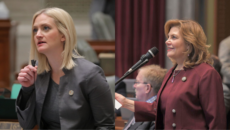JEFFERSON CITY, Mo. — A museum in Kansas City dedicated to Missouri’s steamboat heritage will be out of a home in less than a decade and one lawmaker is aiming to relocate it to the Capital of the Show-Me State.
Sen. Mike Bernskoetter, Historian Bob Priddy, and David Hawley want to relocate the Arabia Steamboat Museum to Jefferson City and expand the exhibits in the process.
SB 322, filed by Bernskoetter, would create the Steamboat Legacy Fund and the funding source would be increasing the gaming commission’s entry fee for Missouri’s riverboat casinos up to $3 from $2.
That fund would initially be used to build two new museums in Jefferson City. One, for a dedicated space big enough for the state museum and the second, would be a museum dedicated to the history of steamboats. There is no sunset currently in the bill.
Rep. Dave Griffith said he plans to introduce a companion bill in the House.
“To tell that chapter of history, from the 1820s to the ‘70s — and to dig up one boat from each decade — would tell, really, not just the history of the river, but the history of the development of the West and it’s a history that’s not told,” Hawley said, who was one of the five folks to found and dug up the Arabia steamboat.
“We tell the stories of the trains, the wagon trains, the Pony Express and all that, but you won’t find chapters of history about steamboats. It’s a lost history.”
It’s a history that has been showcased at the Arabia Steamboat Museum in Kansas City since 1991. The museum is named after the first steamboat they recovered from the Missouri River, the Arabia, which sank in 1856.
In 1988, Hawley was part of the crew that found the sunken Arabia steamboat buried about 45 feet under a farm field and excavated it. Those five individuals formed a foundation which owns that discovery — and others they have since complete — and display its contents.
According to Hawley, roughly 80,000 people visit the Arabia Steamboat Museum every year.
“Eighty percent of the folks who come to see the Arabia Steamboat Museum come from outside Kansas City, that exceed a 200-mile radius. We get school groups from St. Louis, St. Joe, Springfield, and Kansas. But the Arabia has surpassed the regional attraction — we get a lot of visitors from California and Florida and all over. They travel to see it,” said Hawley.
Kansas City’s lease with the Arabia Steamboat Museum expires on November 13, 2026. So the Arabia is looking for a new home and Bernskoetter, and others, are determined to see that history remain in Missouri.
“I filed Senate Bill 322 to keep the museum and its contents here in Missouri,” said Bernskoetter.
Currently, the vision for a Jefferson City steamboat museum includes several different levels that would showcase the Arabia and other steamboats that sank in the Missouri River during the six decades they traveled the often treacherous river.
There were around 200 steamboat wrecks along the Missouri River just between St. Louis and Kansas City, and Hawley has identified the sites of 11 of those. The foundation that owns the Arabia Steamboat is ready to recover one of those, but has nowhere to display it at the current location.
The Malta sank in 1841 at a bend in the river, which was later named for the wreck, and Hawley believes it will be a great addition to a steamboat museum. He noted that the History Channel wants to do the story about the recovery of the Malta.
The museum in Jefferson City would be ran similarly to the Smithsonian in Washington, D.C., Hawley projected. The Smithsonian building is owned by the government but the exhibits are privately owned and ran.
Building a museum is no small task and requires millions of dollars. This is where the proposed casino admission fee hike comes into play.
Increasing the entry fee for riverboat casinos with $1 dedicated to the Steamboat Legacy Fund would generate the necessary funds over several years to complete the steamboat museum and a new home for the State Museum.
Priddy recognizes that there is still a long road ahead to this plan becoming a reality. They are expecting some opposition on the fee increase — which is still at the original rate set in 1994 — but are willing to put in the work to make this a reality.

Alisha Shurr was a reporter for The Missouri Times and The Missouri Times Magazine. She joined The Missouri Times in January 2018 after working as a copy editor for her hometown newspaper in Southern Oregon. Alisha is a graduate of Kansas State University.




















